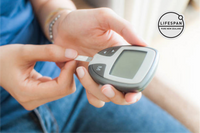
Introducing Dahlia4: Natural Blood Glucose Support
Developed by Otago University, Dahlia4 is a groundbreaking natural supplement for managing blood glucose levels. Combining the best of nature and science, it offers a safe and effective way to support your health.
Why Dahlia4?
Natural Ingredients: Carefully selected for their synergistic effects on blood glucose.
Scientifically Proven: Rigorously tested for efficacy and safety.
Holistic Health: Aids in overall well-being when used alongside a balanced diet and exercise.
Dahlia4 is more than a supplement; it's a step towards a healthier, more balanced life. Experience the natural way to manage your blood glucose with Dahlia4.
Recent posts

About the Author
Lifespan NZ, bolstered by over 60 years of experience, features a team of experts including Ben Winters, a key member and the author of our insightful blogs. Specialising in refining extracts from a diverse range of natural sources and well-versed in farming practices, our team's expertise was a pivotal reason why Otago University chose Lifespan NZ to develop a unique, research-backed blood sugar supplement, into an end product.

How to achieve healthy insulin levels
By Ben Winters
If you are feeling more fatigued than usual, experiencing excessive thirst, and making frequent trips to the bathroom, it may be an indication that something is not quite right in your body.
These symptoms might seem random, but they can be indicators that something is not quite right with your insulin levels.
Insulin is a crucial hormone produced in your body by your pancreas.
Its primary role is to regulate the amount of glucose (sugar) in the bloodstream and promote its absorption into cells, providing them with the right amount of energy to function.
Essentially, after you eat a meal and your blood sugar levels rise, insulin is released to help transport this glucose into cells, lowering your blood sugar levels to a safe range.
Without proper insulin function, cells can't access glucose effectively, leading to elevated blood sugar levels that can cause several health issues.
When your body's insulin levels are not balanced, it disrupts the energy supply, leading to symptoms like unusual hunger, weight changes, mood fluctuations, blurry vision, and persistent fatigue.
These are warning signals your body sends when insulin levels are either too high or too low, potentially leading to conditions such as insulin resistance, prediabetes, or even type 1 and type 2 diabetes.
Insulin resistance is a condition in which the body’s cells start ignoring the signals sent by insulin.
Imagine it as a miscommunication between insulin and the cells; even though the pancreas is producing enough insulin, the cells are not responding effectively.
As a result, glucose accumulates in the bloodstream instead of being utilised for energy. The body reacts by producing more insulin, placing stress on the pancreas and leading to chronically elevated insulin levels. This process is insidious because, for many, it progresses unnoticed, gradually taxing the body's systems.
The development of insulin resistance is influenced by several factors, often combining genetic predisposition with lifestyle choices.
Poor dietary habits, lack of physical activity, excessive weight, especially around the abdomen, and certain health conditions can escalate the risk.
When insulin resistance occurs, the next stage can be prediabetes. During this phase, blood sugar levels are higher than normal but not yet high enough for a diabetes diagnosis.
However, it serves as a warning that all is not right in the body and if diet or lifestyle changes are not made, there is a strong chance that type 2 diabetes will develop.
Escalating from prediabetes, type 2 diabetes is when the pancreas can no longer keep up with the heightened demand for insulin, which is vital for maintaining blood sugar at safe levels.
The consequence is a dual burden: the strain of insulin resistance and the gradual failure of insulin-producing cells within the pancreas. This stage manifests in more severe symptoms and complications, impacting various organs and systems within the body.
At this point, the condition becomes a balancing act, requiring careful management of blood sugar levels to prevent further health complications. Early detection and lifestyle changes are important to effectively slow or halt the progression from insulin resistance to full-blown diabetes.
Type 1 diabetes is different to other forms of diabetes due to its autoimmune nature.
With type 1 diabetes, the body's immune system, designed to attack foreign invaders, mistakenly targets and destroys the beta cells in the pancreas responsible for insulin production.
This leaves individuals with type 1 diabetes deficient in insulin production, disrupting the regulation of blood glucose levels.
Unlike type 2 diabetes, where lifestyle factors play a significant role, type 1 often begins in childhood or young adulthood and is not linked to diet or lifestyle.
Although its exact cause remains unclear, it's believed that genetics, alongside certain environmental factors, might trigger the autoimmune response leading to the condition.
Managing type 1 diabetes revolves primarily around administering insulin to maintain balanced blood sugar levels, as the body cannot produce sufficient insulin on its own.
This external regulation of glucose becomes an integral part of daily life and involves regular monitoring of blood sugar levels, insulin injections, or the use of an insulin pump to deliver a steady supply of insulin to the body.
Additionally, individuals must carefully balance their food intake, physical activity, and insulin therapy to prevent blood sugar levels from swinging too high or dipping too low.
This delicate balancing act is crucial to avoid both immediate and long-term health complications, emphasising the distinctive, persistent nature of type 1 diabetes management.
Living with type 1 diabetes requires a proactive approach to manage insulin levels effectively.
The key to this is regular blood glucose monitoring throughout the day to make informed decisions about insulin doses.
Modern technology, such as continuous glucose monitors (CGMs) and flash monitoring, can provide real-time glucose readings and reduce the need for finger-prick tests, offering a comprehensive view of blood sugar levels around the clock.
Insulin therapy itself can be administered using traditional insulin injections or through insulin pump therapy.

The latter delivers continuous rapid-acting insulin and allows the wearer to program bolus doses of insulin around mealtimes, providing a more flexible and precise approach to their regimen.
Beyond insulin administration, maintaining a consistent meal schedule, understanding how different foods impact blood sugar, and adjusting carbohydrate intake and insulin around physical activity are crucial for preventing hypo- or hyperglycemia.
Importantly, mental health support is also advised, as managing type 1 diabetes can be emotionally challenging, warranting a holistic approach to care that encompasses both physical and emotional well-being.
Type 2 diabetes is a distinct condition, separate from type 1 diabetes, with different underlying causes and management strategies.
Type 2 diabetes has become a global epidemic, with statistics from health organisations highlighting an alarming rise in cases. As of the last few years, over 400 million people worldwide are grappling with this condition, a figure that's projected to soar in the coming decades.
This increase is strongly linked to several combined factors, especially more urban living, less active lifestyles, and rising obesity rates, all contributing greatly to its beginning and spread.
The central issue with type 2 diabetes is insulin resistance, where the body's muscle, liver, and fat cells become de-sensitised to insulin, impeding proper glucose absorption and leaving excess amounts in the bloodstream.
This condition doesn't develop overnight but is the culmination of years of consistent high blood sugar levels, often compounded by excess body weight and physical inactivity.
The consequence is a vicious cycle where the pancreas produces more insulin to compensate, exacerbating both insulin and glucose levels in the blood and escalating the risk and severity of complications.
This global health crisis underscores the urgent need for preventive public health strategies, lifestyle modification programs, and broadened access to diabetes care to stem the tide of this life-altering disease.
Lifestyle interventions stand as powerful tools in preventing and managing type 2 diabetes.
To address the factors that contribute to insulin resistance, lifestyle adjustments usually need to be made.
The most important changes that need to be made usually involve the diet.
Adopting a diet rich in whole foods like vegetables, fruits, lean proteins, and whole grains while reducing the intake of processed foods, especially those high in refined sugars, can significantly improve blood sugar levels and insulin sensitivity.
Portion control also plays a critical role, as excessive calorie intake can lead to weight gain, a strong risk factor for diabetes.
Regular physical activity is also important. Exercise helps manage weight and increases insulin sensitivity by encouraging cells to utilise glucose more efficiently, a direct counter to insulin resistance.
Another critical aspect is consistent monitoring of blood glucose levels to understand how different foods and activities affect your body, enabling more informed decisions to keep blood sugar levels stable.
Lifestyle management extends beyond diet and exercise, including adequate sleep and stress reduction.
High stress and poor sleep quality have been shown to affect blood sugar levels and insulin sensitivity adversely.
In some individuals, these lifestyle interventions may not only prevent the progression from prediabetes to type 2 diabetes but also potentially reverse the course of the condition, underscoring the profound impact of daily habits on health outcomes.
Through a holistic approach that integrates these lifestyle modifications, individuals can create a health-promoting environment, empowering them to manage or potentially steer clear of type 2 diabetes.
Prediabetes is the warning stage that people go through before developing type 2 diabetes.
Prediabetes occurs when blood sugar levels are higher than normal, but not as high as the clinical threshold for diagnosing type 2 diabetes.
This stage is intrinsically linked to insulin resistance, a condition where the body still produces insulin but the hormone is less effective at moving glucose into the cells.
Without intervention, insulin resistance during prediabetes can progress, eventually culminating in type 2 diabetes.
The subtlety of prediabetes is what makes it both dangerous and reversible; often, it presents with no clear symptoms, going unnoticed until progressing further.
Recognizing it early, typically through routine blood sugar screenings, especially for those with obesity, high blood pressure, or a family history of type 2 diabetes, is key to halting the advance of diabetes.
If detected, lifestyle changes focused on healthy eating, increased physical activity, and weight loss can significantly improve insulin sensitivity and potentially bring blood glucose levels back to normal. Monitoring blood sugar levels becomes part of routine healthcare, ensuring that any progression is caught early.
Essentially, prediabetes is a warning sign which gives people a chance to take immediate action to prevent the onset of type 2 diabetes.
By taking action it's possible to reverse insulin resistance and maintain healthier blood sugar levels, and so prevent the occurrence of 2 diabetes.
Insulin plays an instrumental role in managing the body's glucose levels, ensuring cells receive the energy they need.
However, when insulin levels become unbalanced, it can lead to a number of issues, from insulin resistance and prediabetes to the onset of type 1 and type 2 diabetes.
While type 1 diabetes, an autoimmune condition, necessitates lifelong insulin administration due to the body's inability to produce insulin, type 2 diabetes arises primarily from insulin resistance, where the body's cells don't respond properly to insulin.
This resistance can escalate to a full-blown type 2 diabetes diagnosis if not addressed promptly. Lifestyle choices are pivotal in the prevention and management of type 2 diabetes.
Incorporating a nutrient-rich diet, consistent physical activity, regular sleep, and stress reduction can significantly influence blood sugar levels and insulin sensitivity. In some cases, adopting these habits can even reverse the trajectory of the condition, emphasising the profound power of daily choices on health outcomes.
Early detection in the prediabetic phase and immediate lifestyle intervention stand as the best defense against progression to type 2 diabetes.
Prediabetes acts as the body's alarm system, signalling that while blood sugar levels are elevated, they have not yet crossed into the diabetic range.
It's intrinsically linked to insulin resistance and, if left unchecked, can become a precursor to type 2 diabetes. Yet, its silent nature often means it goes undetected until more significant health issues arise.
Regular monitoring and proactive measures can help individuals reverse this trend, re-establishing healthier insulin and blood sugar balances.
Recognising the distinct nature of type 1 and type 2 diabetes, understanding their links to insulin, and employing preventive and management tactics are vital steps to combating the global diabetes epidemic.





